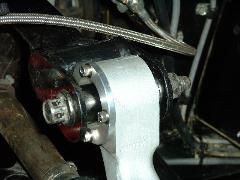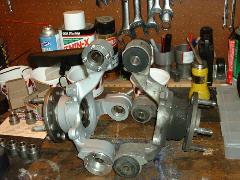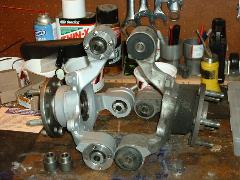Spherical Bearing Conversion
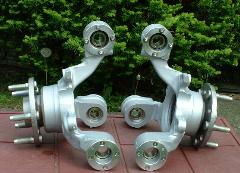 In the spring of 2002 we had one of
the top drivers in our club (COMSCC) drive the Cobra at Loudon. After only
a few laps, he came back in, full of criticism for the car's transient
behavior. He pointed out that it was very unstable and nonlinear
on turn-in for the only high speed corner at Loudon, turn 8. He
said the car literally scared him, more than any other car he'd
driven - and he came closer to spinning it than he had any other
car.
In the spring of 2002 we had one of
the top drivers in our club (COMSCC) drive the Cobra at Loudon. After only
a few laps, he came back in, full of criticism for the car's transient
behavior. He pointed out that it was very unstable and nonlinear
on turn-in for the only high speed corner at Loudon, turn 8. He
said the car literally scared him, more than any other car he'd
driven - and he came closer to spinning it than he had any other
car.
Once we calmed down, we realized
he was right, and that both Nate and I had been driving around
the problem. After some analysis and consultation with Doug Arnao,
I concluded that the flexible bushings in the T-bird rear spindles
were allowing the rear wheels to change toe and camber under load.
Although we had replaced the
original rubber bushings with urethane ones, there was still sufficient
movement to cause significant toe change, which is a very bad
thing!
Think about it: the spindle
pivots, which control toe, are only 10" apart. The wheel
is 17" in diameter. If each bushing compresses 1/16",
the spindle will change toe by 1/8", and the wheel will change
toe by almost 1/4"!
As a result, any time the driver
steps on the throttle, the wheels toe in. If the driver brakes,
the wheels toe out (which explains the twitchy behavior when we
first hit the brakes!) If the driver is on the power when turning
in, the cornering load will overpower the forward thrust load
and the wheels will go from toe in to neutral toe, which is effectively
toeing out.
All of this describes exactly
what the Cobra was doing.
Fixing the Problem
 To address this problem, Doug Arnao
recommended that we replace the urethane bushings with spherical
bearings. This would involve modifying the spindles to accept
the bearings, and designing some additional pieces to make it
all work.
To address this problem, Doug Arnao
recommended that we replace the urethane bushings with spherical
bearings. This would involve modifying the spindles to accept
the bearings, and designing some additional pieces to make it
all work.
After considerable thought and
research, I decided to go ahead with this project.
The results were dramatic. All
the transient stability is gone. The car doesn't dart over bumps,
it's stable under braking, and linear in turn-in.
It's great! After his first
session in the car at Watkins Glen with the new spindles, Nate
said, "this is the first time I've ever driven this car that
there's been nothing wrong with the handling."
Tire temps confirmed the improvement.
In the past, whenever we measured the tire temperatures, the rears
were always higher than the fronts, even when the car was understeering.
After the spherical bearing conversion, we took tire temperatures
at Loudon and for the first time, the front tire temps were higher
than the rears.
Previously we had disconnected
our rear anti-roll bar to help cope with the transient instability.
As a result of the improved grip at the rear and improved transient
stability, not only were we able to reconnect the rear anti-roll
bar, but we wound up with it on its stiffest setting!
Clearly keeping the rear wheels
pointing in the right direction, instead of letting them squirm
around, makes the rear tires work better.
Spherical Bearing Conversion
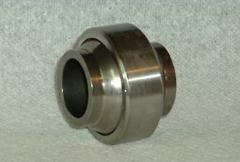 I designed a conversion which replaced
all six urethane bushings in the rear spindles with spherical
bearings.
I designed a conversion which replaced
all six urethane bushings in the rear spindles with spherical
bearings.
At right is a photo of the upper
spherical bearing. The lower spherical bearings are slightly different
(they are not the high misalignment type, so they don't have the
small flanges on the ball) but they install and function the same
way.
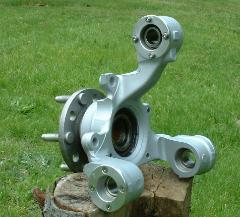 At right is the spindle with the bearings
installed.
At right is the spindle with the bearings
installed.
This was not a trivial job.
Tolerances are tight, both in terms of "meat" on the
casting to do the necessary machining and yet leave room for drilling
and tapping the retaining cap screws, and in terms of clearance
inside the lower control arm's U-shaped brackets. The dimensions
of the new parts and the modifications have to be spot on.
I spent a couple of months doing
research and working up drawings. I got a spare set of spindles
so I could get really accurate measurements, found spherical bearings
of the correct dimensions, measured the control arms on the Cobra,
and then did all the calculations and made up drawings for the
machinist.
I had the machine shop bore
out the spindle to the OD of the spherical bearing, about 2/3
of the way through. This leaves a shoulder which keeps the spherical
bearing from going out the other side.
While standard spherical bearings
worked fine on the lower pivots, I needed to use high misalignment
bearings on the upper arm because these were the only ones I could
find that had the right OD, large enough to get a good shoulder
inside the spindle but not so large that there wouldn't be enough
meat left on the spindle for the bolts that attach the cap.
But this works out well, because
the upper arm goes through some fore and aft movement anyway,
so the arm needs to rotate some around its axis.
Capturing the Bearing
Once the spindles were
bored out to accept the spherical bearings, I had the shop make
an aluminum retaining cap for each bearing. This cap has a flange
on the inner side which clamps the spherical bearing against the
shoulder in the spindle when you tighten the screws.
At right are photos of the upper
and lower caps installed on the spindles, with the spindles bolted
to the control arms.
This is a much better way to
retain the bearing than using snap rings, which is what people
often do in this situation. Since there are axial loads on the
bearings, if you use snap rings the bearings will eventually work
loose and develop play inside the spindle, ruining the spindle.
My cap crushes the bearing against the shoulder so there is no
movement.
Steel Spacers
I also had the shop make
steel inner spacers, which go on the 14 mm bolt and butt up against
the ball to fill the gap between the blades on the U-shaped bracket
on the control arm.
In the photo at upper right,
you can see the spacers sitting on the workbench to the left of
the new spindle, which has the bearings and caps installed. At
right is the old spindle with the urethane bushings.
In the lower photo, all but
two of the spacers have been inserted into the ball in the spherical
bearings, so the spindle is just about ready to go into the control
arms. Note the shoulder on the inner end of the spacers. This
helps retain the spacer in the ball during assembly and makes
installation into the car a snap.
Below right is a shot of the
spindle installed in the car. Note that we left off the quad shocks;
they don't do anything useful once you've installed the spherical
bearings.
What Would it Cost?
 This isn't a cheap conversion; the six
bearings cost $350 total, plus a set of used spindles and the
machine work. One machine shop quoted me $850 for the machine
work and another estimated $1300! My feeling is that $850 is probably
about what you should expect to pay for the work by a machine
shop that is familiar with this type of job.
This isn't a cheap conversion; the six
bearings cost $350 total, plus a set of used spindles and the
machine work. One machine shop quoted me $850 for the machine
work and another estimated $1300! My feeling is that $850 is probably
about what you should expect to pay for the work by a machine
shop that is familiar with this type of job.
I think about $1400-1500 would
be a reasonable figure for the entire job, including six spherical
bearings, used spindles, and machine work on the spindles plus
fabrication of aluminum retaining caps, steel spacers, and the
small bolts to hold the caps in place.
I can get a break on the rate
for the machine work. I should be able to get you a set made up
for less than what you'd probably pay to have it done yourself,
and at the same time spare you all the work of figuring out how
to do it.
If you're interested, contact
me.
 In the spring of 2002 we had one of
the top drivers in our club (COMSCC) drive the Cobra at Loudon. After only
a few laps, he came back in, full of criticism for the car's transient
behavior. He pointed out that it was very unstable and nonlinear
on turn-in for the only high speed corner at Loudon, turn 8. He
said the car literally scared him, more than any other car he'd
driven - and he came closer to spinning it than he had any other
car.
In the spring of 2002 we had one of
the top drivers in our club (COMSCC) drive the Cobra at Loudon. After only
a few laps, he came back in, full of criticism for the car's transient
behavior. He pointed out that it was very unstable and nonlinear
on turn-in for the only high speed corner at Loudon, turn 8. He
said the car literally scared him, more than any other car he'd
driven - and he came closer to spinning it than he had any other
car.


